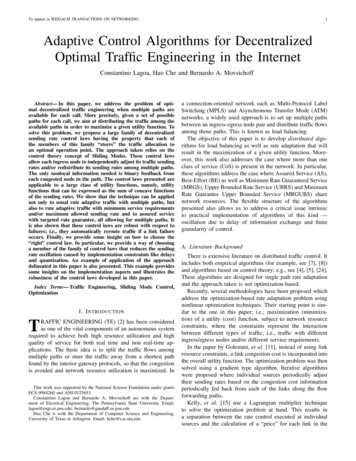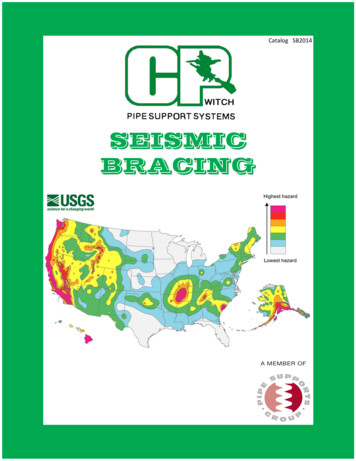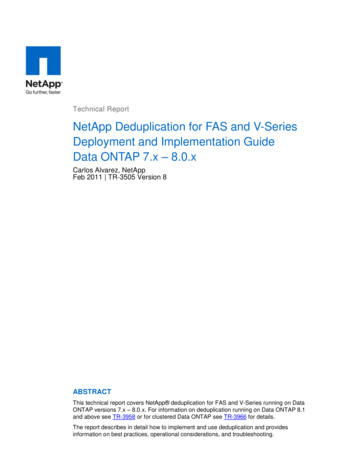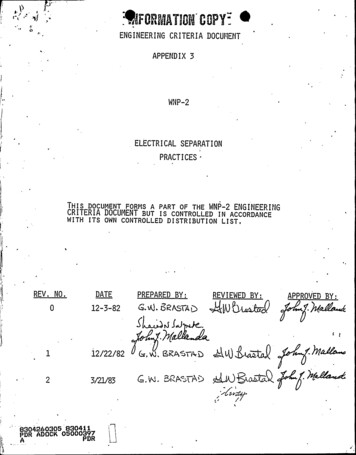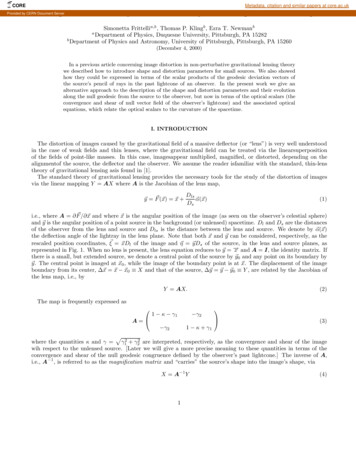
Transcription
To appearMetadata,in Phys.citationRev. D2001)and(Januarysimilar papersat core.ac.ukCOREImage distortion from optical scalars in non-perturbative gravitational lensingProvided by CERN Document ServerSimonetta Frittellia,b , Thomas P. Klingb , Ezra T. NewmanbDepartment of Physics, Duquesne University, Pittsburgh, PA 15282bDepartment of Physics and Astronomy, University of Pittsburgh, Pittsburgh, PA 15260a(December 4, 2000)In a previous article concerning image distortion in non-perturbative gravitational lensing theorywe described how to introduce shape and distortion parameters for small sources. We also showedhow they could be expressed in terms of the scalar products of the geodesic deviation vectors ofthe source’s pencil of rays in the past lightcone of an observer. In the present work we give analternative approach to the description of the shape and distortion parameters and their evolutionalong the null geodesic from the source to the observer, but now in terms of the optical scalars (theconvergence and shear of null vector field of the observer’s lightcone) and the associated opticalequations, which relate the optical scalars to the curvature of the spacetime.I. INTRODUCTIONThe distortion of images caused by the gravitational field of a massive deflector (or “lens”) is very well understoodin the case of weak fields and thin lenses, where the gravitational field can be treated via the linearsuperpositionof the fields of point-like masses. In this case, imagesappear multiplied, magnified, or distorted, depending on thealignmentof the source, the deflector and the observer. We assume the reader isfamiliar with the standard, thin-lenstheory of gravitational lensing asis found in [1].The standard theory of gravitational lensing provides the necessary tools for the study of the distortion of imagesvia the linear mapping Y AX where A is the Jacobian of the lens map,Dlsα ( x) y F ( x) x Ds(1)i.e., where A F / x and where x is the angular position of the image (as seen on the observer’s celestial sphere)and y is the angular position of a point source in the background (or unlensed) spacetime. Dl and Ds are the distances ( x)of the observer from the lens and source and Dls is the distance between the lens and source. We denote by αthe deflection angle of the lightray in the lens plane. Note that both x and y can be considered, respectively, as therescaled position coordinates, ξ xDl of the image and η y Ds of the source, in the lens and source planes, as represented in Fig. 1. When no lens is present, the lens equation reduces to y x and A I, the identity matrix. Ifthere is a small, but extended source, we denote a central point of the source by y0 and any point on its boundary by y . The central point is imaged at x0 , while the image of the boundary point is at x. The displacement of the imageboundary from its center, x x x0 X and that of the source, y y y0 Y , are related by the Jacobian ofthe lens map, i.e., byY AX.(2)The map is frequently expressed as A γ21 κ γ1 γ21 κ γ1 (3)pwhere the quantities κ and γ γ12 γ22 are interpreted, respectively, as the convergence and shear of the imagewih respect to the unlensed source. [Later we will give a more precise meaning to these quantities in terms of theconvergence and shear of the null geodesic congruence defined by the observer’s past lightcone.] The inverse of A,i.e., A 1 , is referred to as the magnification matrix and “carries” the source’s shape into the image’s shape, viaX A 1 Y1(4)
We are here interested in obtaining an analog of this approach to distortion in a generic case that applies regardlessof the strength of the gravitational field and without reference to thin lenses. We refer to this as a non-perturbativeapproach to image distortion.In this paper, we consider small elliptical sources, which can be completely described by three shape parameters:area, semiaxes ratio and semiaxes orientation relative to a fixed direction. They are dealt with by means of connectingvectors in the null geodesic congruence that forms the past lightcone of the observer. The source and image descriptionsin terms of Jacobi fields are developed in full detail in our preceding paper [2], where we obtain expressions for thethree parameters that measure the “total” distortion of the image with respect to the source: the image’s solid angle,semiaxes ratio and orientation as compared to the source’s parameters.In addition, we consider the distortion of the pencil of rays of the elliptical source as it travels towards the observer,where it eventually defines the image. This is an “infinitesimal” distortion; The distortion of the image is the resultof the cumulative effect of such infinitesimal distortion of the pencil of rays along the null geodesic from the sourceto the observer.Jacobi fields appear naturally in the context of gravitational lensing [3,4,1]. They proved particularly useful inunderstanding spacetime singularities (see [5], and [6]). More recently, Jacobi fields have been used [7–9] to understandissues in the approach to the Einstein equations referred to as null surface formulation [10,8]. The feature of Jacobifields that we focus on in this paper is the fact that the geodesic deviation equations, governing Jacobi fields, acquire aparticularly simple form in terms of the dynamics (the optical or Sachs equations) for the optical scalars (convergence,ρ, and shear, σ) of the null geodesic congruence.In this paper we derive a relationship between the distortion of the pencil of rays of the elliptical source and theoptical scalars of the geodesic congruence. This relationship applies in arbitrary spacetimes, without reference to anyapproximation. Even though our derivation makes use of a non-perturbative definition of image distortion based onJacobi fields, the Sachs equations allow us to eventually eliminate the Jacobi fields and obtain a relationship purelybetween the change in shape of the pencil of rays and the optical scalars. Via the optical equations, this can beinterpreted as a cause and effect relationship directly between the curvature of the spacetime and the distortion ofthe image.Here, as in our companion paper [2], we assume that the source being imaged does not lie across a caustic of thepast lightcone of the observer.II. SUMMARY OF NON-PERTURBATIVE IMAGE DISTORTIONWe summarize, for easy reference, the salient aspects of our approach to image distortion as developed in [2], andas represented in Fig. 2 (Readers familiar with [2] may want to skip this section). A non-perturbative approach todistortion requires, as a fundamental tool, a non-perturbative lens mapping: a mapping from the image location to thesource location that does not rely on weak-field nor thin-lens regimes. As explained in [11–13], such a lens mappingcan be obtained, in principle, from the expressionz a F a (z0a (τ ), s, θ, φ)a(5)z0a (τ ),which gives the coordinates z of source points on the past lightcone of the observer, located on the worldlinein terms of the null geodesic that connects the source with the observer. Eq. (5) can be obtained, for instance, byintegrating the null geodesic equation, or by solving the eikonal equation [14,15]. (Lens equations in generic spacetimeswithout the thin-lens approximation are also being considered by other authors [16,17]. In particular, see [18] for exactlensing in Kerr spacetime.) The angles (θ, φ) represent the direction of the null geodesic at the observer’s location andspecify the angular location of the image on the celestial sphere in standard spherical coordinates, whereas s gives theparameter distance of the source to the observer along the null geodesic (it can be thought of as an affine parameter).The tangent vectors to the null geodesics in the lightcone are F a.(6) sAssociated with each null geodesic, there is a pair of parallel propagated spacelike vectors, (ea1 , ea2 ), which span thespace of spacelike vectors orthogonal to a , and which allow us to compare angles at two different locations along anull ray. The parallel-propagated basis is defined by a b b ea1 b b ea2 0,e1 · e2 · 0,e1 · e1 e2 · e2 1,e1 · e2 0.2(7)(8)(9)(10)
Even though such parallel propagated basis are only defined up to a fixed rotation, in principle a unique such basiscould be picked in the case that the electromagnetic radiation emitted by the source is polarized. In such case, thepolarization vector of the radiation is parallel transported [1] and defines for us one leg, say ea1 , of our basis.The situation that we consider is that of a small source located at the value s along the geodesic. More specifically,s represents a central point in the intersection of the source’s worldtube with the observer’s past lightcone. Byassumption, the source’s worldtube does not intersect the caustic of the lightcone, therefore the intersection withthe lightcone is continuous and produces a single (distorted) image. The source’s visible shape is defined by thisintersection and, as a set, is connected to the observer by a pencil of rays. If the source is small, the pencil ofrays consists of a bundle of null geodesics that are neighboring to a fixed null ray from the source’s “center” to theobserver. Points on the pencil are thus reached by connecting vectors (Jacobi fields). These are solutions to thegeodesic deviation equation. Given two linearly independent solutions, (M1a (s), M2a (s)), any other Jacobi field Z a canbe expressed asZ a (s) αM1a (s) βM2a (s)(11)where α and β do not depend on s. One natural basis of Jacobi fields is found by taking derivatives of the lensmapping, in the formafa z ,M1 θfa M21 z a.sin θ φ(12)Although all Jacobi fields associated with the observer’s past lightcone vanish at the observer’s location (the apex ofthe lightcone), these two are such that their s derivatives are orthonormal at the observer’s location. As s varies alonge i (s) Mfa eia .the null geodesic, their components along (ea1 , ea2 ) form an s dependent matrix that we refer to as JjiJ i (s) 1 ej as s 0.We see that, by construction, se.This matrix evaluated at the source’s location s defines for us the Jacobian of the lens mapping, denoted JNamely, the Jacobian of the lens mapping isδji ee (s ),J J(13)e 1 is our magnification matrix . Notice that, in a weak-field, thin-lens regime, our Jacobian Je isand is its inverse Jrelated to the Jacobian A of the thin-lens theory viaA eJ,s (14)which is due to the fact that we have not scaled our Jacobi fields at the source’s location. (In a generic spacetime,i.e., in the absence of a flat background, there is no geometric meaning to such a scaling.)For ease of describing the source’s shape, it is convenient to use a basis of Jacobi fields (M1a , M2a ), rather thanfa ), that is identical to the parallel propagated basis (ea , ea ) at the source’s location. See Fig. 3. We introducef(M1a , M21 2the notation that any quantity defined or evaluated at the source is preceded by a . We thus have M1a ea1 ,M2a ea2 .(15)(16)e 1 )j Mfa (s)Mia ( Jji(17) fa ) we have thatfa , MIn terms of (M12If we define the components of Mia in the parallel propagated basis eai byJ ij (s) Mja (s)eja ,(18)where eja is the dual to eaj , we see immediately thateJ ij (s ) ( J 1 k a if e)j Mj ae ( Ji 1 k ie)j Jk δji ,e (s) δ i , thatas required by Eqs. (15)-(16). One also sees, from lims 0 s 1 Jjj3(19)
1e 1 )i ,lim J ij (s) ( Jjs(20)s 0an important result that allows us to map the source’s shape to the image’s shape on the observer’s celestial sphere.This result is fundamental to the construction in this paper, since it allows us to obtain the magnification matrix bycontinuously moving along the null geodesic from the source to the observer.It is important to notice that the vectors (ea1 , ea2 ) can be expressed in terms of (M1a , M2a ), byea1 α cos(λ ν)M1a β cos λM2a ,ea2 α sin(λ ν)M1a β sin λM2a ,(21)(22)wheresα sβ M2 ·M2M1 · M1 M2 · M2 (M1 · M2 )2(23) M1 ·M1M1 · M1 M2 · M2 (M1 · M2 )2(24)M1 ·M2cos ν M1 ·M1 M2 ·M2(25)and λ is determined, up to a constant, bydM1 ·M2logλ̇ p2 M1 · M1 M2 · M2 (M1 · M2 )2 ds M2 ·M2M1 ·M2 .(26)At the source, by Eqs. (15)-(16), we have α 1, β 1,πν ,2 λ π.2(27)A small elliptical source at s of semiaxes L and L , oriented so that the semimajor axis lies at an angle δ withis described parametrically by ae1 , Y a (t) Y 1 (t) ea1 Y 2 (t) ea2 Y 1 (t) M1a Y 2 (t) M2a ,where the components Y i (t) (for t [0, 2π]) can be specified asr A1Y ( R cos t cos δ sin t sin δ) ,Rr AY 2 ( R cos t sin δ sin t cos δ) .R(28)(29)(30)Here R is the ratio of the semiaxes (R L /L ) and A is referred to as the area of the ellipse, even though it isdefined simply as the product of the semiaxes (A L L ). We can follow the lightrays that connect each point ofthis source with the observer by defining the connecting vector Z a (s, t) asZ a (s, t) Y 1 (t)M1a (s) Y 2 (t)M2a (s)(31)The image is thus obtained by projecting Z a (s, t) along the directions (ea1 , ea2 ), in the limit as s 0:1e 1 )ij Y j (t)X i (t) lim Y j (t)Mja (s)eia ( Js 0 s(32)In order to study the distortion of the image, compared to the shape of the source, we define the shape parametersto be the area of the ellipse A(s), the ratio of its semiaxes R(s) and its orientation δ(s), for each s as the ellipse iscarried by the null geodesics towards the observer. Defining, for short, the following4
a(s) R2 (cos δ)2 M1 · M1 (sin δ)2 M2 · M2 2 sin δcos δM1 · M2 ,11b(s) (1 R2 )(M1 · M1 M2 · M2 ) (1 R2 ) cos(2 δ)(M2 · M2 M1 · M1 )22 (1 R2 ) sin(2 δ)M1 · M2 , c(s) R sin(2 δ)(M2 · M2 M1 · M1 ) 2 cos(2 δ)M1 · M2 ,(33)(34)(35)it can be seen [2] that the shape parameters can be obtained from the Jacobi vectors (M1a , M2a ) as 1/2 M1 · M1 M2 · M2 (M1 · M2 )2A A!1/2 2a
Image distortion from optical scalars in non-perturbative gravitational lensing Simonetta Frittellia;b, Thomas P. Kling b,EzraT.Newman aDepartment of Physics, Duquesne University, Pittsburgh, PA 15282 bDepartment of Physics and Astronomy, University of Pittsburgh, Pittsburgh, PA 15260 (December 4, 2000) In a previous article concerning image distortion in non-perturbative gravitational lensing .

